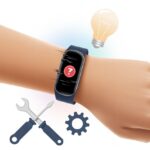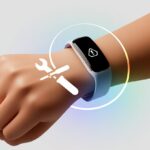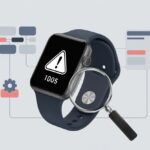Ever get the feeling your smartwatch just wants a break from all those notifications and endless step counting? If you’ve run into error code 1001, don’t freak out—your trusty wrist gadget probably isn’t out to get you. Most of the time, you can fix smartwatch error code 1001 by restarting it or trying a few simple troubleshooting tricks.

We’ve all stared at weird error codes and wondered if we’re just bad at tech. Thankfully, this one’s usually not a big deal.
Let’s roll up our sleeves and get that smartwatch back to tracking time—or at least helping us hit our step goals—without rebooting it fifty times.
If your watch keeps flashing 1001 like it’s trying to tell you something, it might be a charging issue or a sign it needs service. Here’s a troubleshooting guide just in case.
Let’s make sure error codes don’t wreck our day or our wrist style.
Understanding Smartwatch Error Code 1001
When our smartwatch flashes error code 1001, it feels like it’s speaking a totally different language.
Let’s figure out what this error means, why it shows up, and which watches tend to get it the most.
What Triggers Error Code 1001
This error code doesn’t exist just to make us doubt our tech skills—though it sure tries. Usually, it pops up when the watch can’t communicate with another device, most often our phones.
Software bugs and botched updates often cause it too.
Sometimes, a weak Bluetooth connection or syncing too many apps at once messes things up. Outdated firmware or a failed pairing attempt can send our watch into panic mode.
If you see error code 1001 after a big update, the new software might not be playing nice with your gadget.
Remember that time you tried pairing your watch with four devices in one afternoon? Yeah, smartwatches have boundaries too.
Common Error Messages and What They Mean
Error code 1001 loves to show up in different disguises. You might see “Something went wrong [1001],” “Connection failed – error code 1001,” or even “Unable to sync, error code 1001.”
All of them basically mean, “Sorry, not working right now.”
Most of the time, these errors mean one of three things:
- The watch can’t talk to your phone
- There’s a hiccup updating the software
- Bluetooth is being difficult
Here’s a quick table to break down what these cryptic messages are actually saying:
| Error Message | What It Means |
|---|---|
| Something went wrong [1001] | General connection problem |
| Connection failed – error code 1001 | Pairing failed, often Bluetooth related |
| Unable to sync, error code 1001 | Sync interrupted, usually by software issues |
Impacted Watch Models
It’s not just one brand that gets hit with error 1001. Apple Watches like to throw this code around, especially during updates or when you try to pair them—just ask anyone on the Apple Community.
Android smartwatches and fitness trackers that rely on Bluetooth syncing get it too.
The more we ask our watches to do—like installing new software or syncing with multiple devices—the more likely we’ll see this error.
Even the newest models aren’t safe when their software acts up. At least we’re not alone—error code 1001 definitely isn’t picky.
Immediate Actions to Fix Smartwatch Error Code 1001
Let’s be real—our smartwatches always seem to throw a fit when we need them most. When error code 1001 pops up, something’s usually off with charging, so let’s dig in and fix it.
Checking the Charger Cable and AC Adaptor
Let’s start with the basics. Grab your charger cable and give it a good look.
Check for frayed wires or bent connectors. If the cable looks like it’s been through a war zone, swap it out for another.
Don’t forget the AC adaptor. Sometimes that’s the real troublemaker.
Try plugging it into a different socket—some outlets just don’t want to cooperate.
A sketchy charging setup is the top reason error code 1001 keeps coming back, so let’s get this right before tossing our smartwatch across the room.
| Problem | What To Do Now |
|---|---|
| Frayed cable | Use a new cable |
| Warm/hot adaptor | Try a different one |
| Loose connection | Firmly reconnect |
Ensuring a Chargeable Battery
Now, about those batteries. They’re tiny but love to cause drama.
If the battery is really drained, your smartwatch might just play dead and throw error code 1001 at you.
Check if the watch does anything at all when you plug it in—like a vibration, a light, or a logo popping up. If it’s totally silent, the battery might be completely flat.
Let it charge for at least 30 minutes before panicking.
If you still get nothing, check the battery contacts. Dust and lint love to hide there.
Use a soft dry cloth or a cotton swab to clean them. Please, don’t use spit—your smartwatch doesn’t want your DNA.
Testing With Normal Charging Procedures
Stick to the basics for this test. Use the charger and cable that came with your watch. Third-party chargers can mess things up more than you’d think.
Plug everything in, make sure it feels snug, and watch for any sign of life on the screen.
If the battery’s really low, you might need to let it charge longer than usual. Try not to press buttons or poke the screen too much—sometimes patience is all it takes.
If none of this works, it might be time for more advanced troubleshooting or to reach out for support. But hey, maybe basic charging will save you from a ranty call to tech support and a smartwatch meltdown.
Dealing With Temperature-Related Charging Problems
Smartwatches can be picky about their environment, especially when charging. If your watch complains about being too hot or too cold, it’s probably time to give it a break and let it adjust.
How Ambient Temperature Affects Charging
Smartwatches like a certain temperature range—too hot or too cold, and they just won’t play along.
Imagine your watch at a fancy spa, refusing to do anything until the vibes are just right.
If the temperature goes outside the ideal range, charging slows down or stops. Most smartwatches prefer somewhere between 50°F and 86°F (10°C and 30°C).
A watch that’s too hot to charge might show an error or just sit there doing nothing. The built-in sensors check if it’s safe before charging starts.
Trying to charge outside this cozy range can bring on more errors or a watch that won’t turn on at all. Charging at the right temp keeps your watch (and your sanity) in check.
Avoiding Direct Sunlight and Hot Surfaces
Sunbathing might be nice for us, but smartwatches? Not so much.
Charging your watch in direct sunlight or on hot surfaces is a classic way to trigger a temperature tantrum.
Window sills, dashboards, or anywhere the sun likes to hang out can heat up your watch fast.
To avoid the dreaded “too hot” error, pick a cool, shaded spot for charging. Here’s a quick list:
- Stay away from window sills and car dashboards
- Don’t put the charger near heaters or vents
- Keep it out of direct sunlight
If your watch overheats, unplug it and let it cool down indoors. Sometimes you just have to wait until it’s back in the recommended charging temperature range.
When Your Watch Is Too Cold to Party
Watches don’t like the cold either. Leave one in a freezing car or a chilly basement and you might get a “too cold to charge” warning.
If that happens, bring it inside and let it warm up slowly. No need for tiny blankets—just let it sit at room temperature for a bit.
Charging in the cold can mess up the battery or make your watch act weird. Be patient—once it’s back in the safe zone, charging should work again.
If you want more info, check out this smartwatch troubleshooting guide.
Diagnosing Persistent Smartwatch Issues
If error code 1001 just refuses to go away, it’s time to get a little more hands-on. Don’t blame your wi-fi just yet—let’s check the power button and the hardware itself.
Using the Power Button for a Soft Reset
We all wish for a magic “fix everything” button. On a smartwatch, the power button comes pretty close.
Hold it down for 10-15 seconds to restart most models and clear out bugs—even error 1001.
Here’s what you do:
- Find the power button (usually on the side).
- Hold it until the screen goes black.
- Wait for the logo, then let go.
Rebooting this way won’t erase your data or make you re-pair with your phone, so it’s a safe first move.
Try this whenever your watch freezes, apps won’t open, or a random error code pops up. If the watch still won’t cooperate, maybe it just needs a nap—a full shutdown and restart might help.
Inspecting for Hardware or Charging Port Damage
If pressing buttons isn’t solving that error code, let’s actually take a real look at the watch. Hardware problems like cracks, water sneaking in, or a stubborn charging port can mess with our smartwatch’s mood.
Start by checking:
- The screen for chips or big scratches
- The body for swelling or dents
- The charging port for dust, dirt, or corrosion
Use a flashlight, or just tilt the watch in the light, to spot anything weird. Seriously, don’t use sharp tools—it’s a watch, not a coconut.
If you see gunk in the charging port, try a soft brush or a little blast of compressed air. That usually does the trick.
If you spot damage that gentle cleaning can’t fix, or you’re just squinting at it in confusion, it’s probably time for a repair shop or to see if there’s any warranty left. No shame in it—everyone drops their gadgets in places they shouldn’t.
When to Seek Professional Help (Yes, Even for Your Watch)
Sometimes, smartwatches need more than a pep talk or a hard reset. Before we blame solar flares or Bluetooth gremlins, it’s good to know when it’s time to bring in real help—and where to find it.
Signs You Need Servicing or Repair
Let’s be honest, not every issue bows to a restart and a hopeful stare. If your Casio smartwatch screen stays black even after charging, or weird error codes like 1001 keep popping up, it’s time to stop poking and call in the professionals.
Physical damage is a huge warning sign. Cracked screens, swollen batteries, or a watch that took a dip and now smells like a science experiment—these are all reasons to get help.
Weird noises, flickering, or random shut-downs? Yeah, those count too.
If your watch keeps crashing, refuses to sync, or charging issues stick around even after swapping cables, there’s probably something deeper going on. After you’ve tried all the usual tricks and the watch still acts haunted, getting a professional inspection and repair really makes sense.
Locating an Authorized Casio Service Center
We all feel a little heroic fixing our own stuff, but for deep smartwatch issues, the pros are the way to go. The best bet is always an authorized Casio service center.
These places use real Casio parts and actually understand what “Error Code 1001” means—even if we just shrug and Google it.
To find one, check Casio’s official website for the nearest spot. Some shops claim they’re “authorized,” but only Casio’s site gives you the legit options—no knockoffs, please.
Call ahead to ask about appointments, what you need to bring, and if warranty coverage applies.
Only at an authorized Casio service center will your wrist tech get the real-deal inspection and repair. For anything more than a simple reset or a quick band swap, let the pros handle it. That keeps your warranty safe and stops you from turning a tiny issue into a total disaster. If you want your smartwatch to stick around, this is the one time to let someone else save the day.
Preventing Error Code 1001: Long-Term Tips
Keeping a smartwatch happy takes more than just good vibes. Regular care and a few smart habits can help dodge frustrating errors like code 1001—and maybe even give your favorite wrist computer a longer life.
Regular Device Inspections and Maintenance
Play detective once in a while and check your smartwatch for trouble. A quick glance at the seals and ports can block water, dust, and last week’s sandwich crumbs from sneaking in.
If you spot damage or loose buttons, take a closer look.
A cleaning routine helps too. Wipe it down with a soft, dry cloth to get rid of fingerprints, sweat, and gunk. Sensors and screens work better that way.
Remember, moisture is the sworn enemy. Keep your watch away from showers, pools, or rain unless it’s actually waterproof—not just “water-resistant on a good day.”
Software needs attention too. Keep firmware and apps updated to dodge glitches and security headaches that can trigger errors like 1001.
Set reminders if you’re forgetful. If it sounds intimidating, just pretend you’re giving your watch a spa day.
If your smartwatch still acts up, don’t feel bad about reaching out to manufacturer support or following a detailed troubleshooting guide.
Best Practices for Charging and Storage
Charging with wild abandon? Not a great idea. Always use the charger and cable that came with your device, or pick certified safe ones. Cheap chargers can make your smartwatch blink out SOS in Morse code.
Keep the charging pins clean to avoid errors from bad connections.
Unplug your smartwatch once it’s charged. Overcharging causes heat, and that’s about as good for electronics as it is for ice cream. When you’re not wearing it, store the watch in a cool, dry spot—keep it away from sunlight and moisture.
If you won’t use your smartwatch for a while, let the battery drop to around 50% before powering it off and stashing it away. Too much or too little charge during storage isn’t great for the battery, and could invite hardware-related malfunctions or—cue dramatic music—error code 1001.
What Happens If Error Code 1001 Cannot Be Fixed?
Sometimes, smartwatches just won’t cooperate. If error code 1001 refuses to budge, things get interesting. You might run into power issues or end up sending your watch off for a little vacation with the pros.
Understanding When Power Will Turn Off
Let’s be real—everyone hopes gadgets will just fix themselves after a deep sigh and a restart. Sadly, that’s not always how it works.
Error code 1001 can block essential functions, especially anything that needs the processor to behave. If the error hangs around, some watches might start to overheat or act like they just ran a marathon.
If the watch senses trouble, it might decide, “Nope, I’m out!” and shut itself down to prevent more damage. It’s not personal; it’s just trying to chill out (literally—some will cool down automatically).
Let it cool before trying anything else, or you risk it deciding to nap for good. Usually, you’ll see a message or a gloomy little symbol, just to keep you guessing.
Here’s a quick table for what to expect:
| Issue | What the Watch Might Do |
|---|---|
| Overheating | Power down, show warning |
| Unresponsive | Freeze on error screen |
| Power failure | Refuse to turn on, flashes |
Prepping Your Watch for Professional Inspection
So, after a few failed fixes (and maybe a dramatic sigh or two), it’s probably time to send your loyal wrist buddy to the experts.
Before you hand over your smartwatch, back up all the important settings and health data—unless you’re feeling adventurous. Disconnect it from your phone, because let’s be honest, nobody wants a clingy device. Also, make sure it’s charged enough to survive the trip, but not so much that it starts causing trouble in the technician’s hands.
Give your watch a quick cleaning. It’s not just polite—it actually helps the pros do their job. Wipe off sweat, dust, or whatever mysterious crumbs have found their way into the band.
Jot down any weird things your watch has done. Seriously, even if it buzzed at 3 am with no explanation, write it down. The more details you can give, the better.
Don’t forget to pack the charger and any accessories. Nobody enjoys hunting for a missing cable at the last minute. Now your smartwatch is ready for the spa treatment it deserves.
- Best Fitness Trackers for Kids Who Move Faster Than Your Wi-Fi - December 1, 2025
- How to use Bluetooth headphones with gym equipment without looking like a techno-ninja - December 1, 2025
- Best Smartwatches for Strava: Track Your Sweat in Style - December 1, 2025






